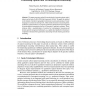Free Online Productivity Tools
i2Speak
i2Symbol
i2OCR
iTex2Img
iWeb2Print
iWeb2Shot
i2Type
iPdf2Split
iPdf2Merge
i2Bopomofo
i2Arabic
i2Style
i2Image
i2PDF
iLatex2Rtf
Sci2ools
124
Voted
KI
1994
Springer
1994
Springer
Combining Spatial and Terminological Reasoning
The paper presentsa method for terminological reasoningabout spatial objects on the basis of a KL-ONE-like framework (LOOM). We apply this method to the domain of deductive geographic information systems and parsing of visual languages.In contrast to existing work, which mainly focusseson reasoningabout qualitative spatial relations, we integrate quantitative information with conceptual or terminological reasoningby the use of "generative"qualitative relations. These relations allow a modularization of systems for terminological reasoning and domain-specificstorageand indexingof, e.g., spatial data. Qualitative relationsare computed on demand from quantitative data during forward-chaining assertional reasoning.
Artificial Intelligence | KI 1994 | Qualitative Spatial Relations | Terminological Reasoningabout | Terminological Reasoningby |
Related Content
| Added | 10 Aug 2010 |
| Updated | 10 Aug 2010 |
| Type | Conference |
| Year | 1994 |
| Where | KI |
| Authors | Volker Haarslev, Ralf Möller, Carsten Schröder |
Comments (0)

